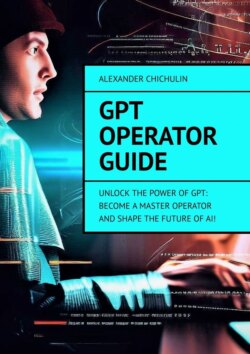Читать книгу GPT Operator Guide. Unlock the Power of GPT: Become a Master Operator and Shape the Future of AI! - - Страница 8
Introduction to GPT Operator
Understanding GPT System Architecture
ОглавлениеTo be an effective GPT Operator, it’s crucial to have a solid understanding of the underlying architecture of GPT systems. While the exact architecture may vary depending on the implementation and specific models used, here is a general overview of the GPT system architecture:
1. Transformer Architecture: GPT models are built on the Transformer architecture, which is a type of deep learning model specifically designed for sequence-to-sequence tasks. Transformers consist of encoder and decoder components that enable efficient processing of sequential data.
2. Encoder Stack: The encoder stack forms the primary component of the GPT architecture. It consists of multiple layers of self-attention and feed-forward neural networks. The encoder takes input text and processes it hierarchically, capturing contextual information at different levels of granularity.
3. Self-Attention Mechanism: The self-attention mechanism allows the model to focus on different parts of the input text when generating responses. It calculates attention weights for each input token, capturing dependencies and relationships between words in the sequence.
4. Positional Encoding: GPT models incorporate positional encoding to account for the sequential order of words. Positional encoding provides the model with information about the relative position of words in the input text, allowing it to understand the sequential context.
5. Vocabulary and Tokenization: GPT models typically use a large vocabulary of tokens to represent words, subwords, or characters. Tokenization is the process of splitting input text into these tokens, enabling the model to process and generate text at a granular level.
6. Fine-Tuning: GPT models are often fine-tuned for specific tasks or domains. Fine-tuning involves training the model on a task-specific dataset to adapt it to the target application. Fine-tuning adjusts the weights and parameters of the pre-trained GPT model to optimize performance for the specific task at hand.
7. Model Deployment and Serving: Once trained and fine-tuned, GPT models are deployed and served as API endpoints or integrated into applications. This allows users to provide input prompts and receive generated text responses from the GPT model.
Understanding the GPT system architecture helps GPT Operators in several ways. It enables them to:
– Configure and set up the infrastructure necessary to run GPT models.
– Optimize model performance by adjusting hyperparameters and fine-tuning techniques.
– Monitor and analyze system behavior to identify performance bottlenecks or errors.
– Collaborate effectively with data scientists and developers to integrate GPT models into applications.
– Troubleshoot issues and errors that may arise during system operation.
By gaining a deep understanding of the GPT system architecture, GPT Operators can efficiently manage and operate GPT systems, ensuring the optimal performance and effectiveness of the deployed models.
